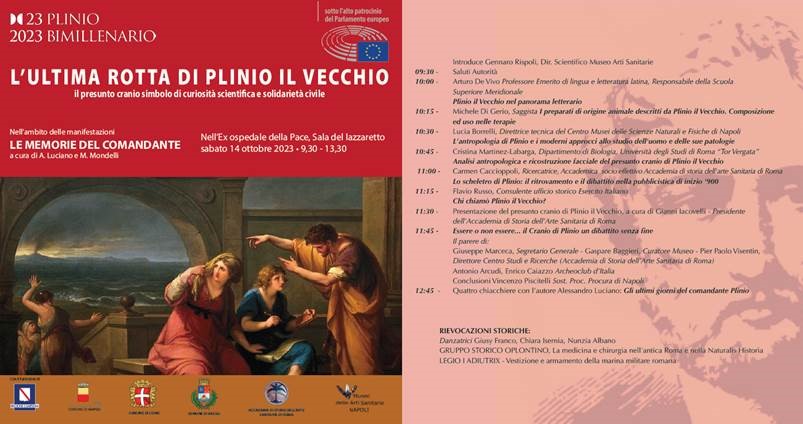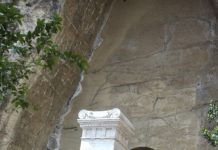Duemila anni fa, nasceva Plinio il vecchio. Una delle figure più eclettiche dell’Antichità. Bacoli, Napoli e Como lo lo celebrano con il convegno internazionale “Le Memorie del comandante” (a cura di Alessandro Luciano e Massimiliano Mondelli), dedicato all’approfondimento degli aspetti caratterizzanti la personalità di Plinio il Vecchio, dei suoi studi e della sua eredità culturale.
L’iniziativa, che gode dell’alto patrocinio del Parlamento europeo, rappresenta l’occasione per rinnovare il legame tra i comuni di Bacoli e Como, luoghi di vita del Plinio ammiraglio e studioso e rientra nel più ampio programma di interventi promossi su tutto il territorio italiano dal Comitato Nazionale per le Celebrazioni dei duemila anni dalla nascita di Plinio il Vecchio, istituito dal Ministero della cultura attraverso conferenze, visite guidate, mostre e spettacoli dal vivo.
La Biblioteca Universitaria di Napoli, parte integrante del Comitato scientifico già dalla prima edizione, partecipa alle celebrazioni ospitando, il 13 ottobre dalle 10, la seconda e la terza sessione del Convegno internazionale. In questa occasione sarà inaugurata la mostra “Plinio va in mostra”, a cura di Maria Lucia Siragusa.
Nella Sala del Lazzaretto all’ex Ospedale della Pace in via dei Tribunali 227, invece, sarà esposto il presunto cranio di Plinio il Vecchio sarà esposto nella Sala del Lazzaretto all’ex Ospedale della Pace in via dei Tribunali 227. Qui sabato 14 ottobre, dalle 9.30 alle 13.30, si terrà un convegno su ‘L’ultima rotta di Plinio il Vecchio tra curiosità scientifica e solidarietà civile’.
Nella terribile eruzione del 79 d. C., Plinio il Vvecchio, in qualità di prefetto, comandava la flotta militare a Miseno. E mentre da lì osservava l’eruzione, fu chiamato d’urgenza da Rectina, una matrona di Pompei e ordinò un intervento di soccorso servendosi di quadriremi che si sarebbero poi disposte a ventaglio da Ercolano a Stabia. Ma, dopo alcune ore, un’ondata di gas velenoso proveniente dal Vesuvio raggiunse la spiaggia di Stabia, uccidendo quanti ancora dovevano imbarcarsi. Tra questi anche Plinio impegnato a mettere in salvo gli abitanti.
Spiega Gennaro Rispoli, direttore scientifico del Museo delle Arti Sanitarie di Napoli: «Un’occasione di una reliquia laica per riflettere su una storia senza fine che lega il territorio vesuviano e quello dei Campi Flegrei, sui fenomeni vulcanici del passato ai timori del presente. Un cranio trovato oltre cento anni fa è l’occasione per aprire un dibattito su veridicità storica, ricerca paleontologica ed interrogativi sulla flotta romana e un tentativo di soccorso riferito nelle ore drammatiche come rendiconto epistolare di Plinio il giovane. Se ne occupa Tacito che chiede informazioni al nipote, Plinio il giovane, sulla fine del prefetto romano. Tra curiosità scientifica e volontà salvifica del prefetto, si legge la più bella storia di mission di Protezione Civile al tempo del 79 d. C.».
Per saperne di più
https://bibliotecauniversitarianapoli.cultura.gov.it/it/1/home
info@ilfarodippocrate.it
http://www.museoartisanitarie.it/

Bun & Museo arti sanitarie/ Naples celebrates Pliny the Elder who was born 2,000 years ago. The enigma of the skull found in the twentieth century
Two thousand years ago, Pliny the Elder was born. One of the most eclectic figures of Antiquity. Bacoli, Naples and Como celebrate him with the international conference “The memories of the commander” (curated by Alessandro Luciano and Massimiliano Mondelli), dedicated to an in-depth study of the aspects characterizing the personality of Pliny the Elder, his studies and his cultural legacy.
The initiative, which enjoys the high patronage of the European Parliament, is an opportunity to renew the link between the municipalities of Bacoli and Como, places of life of the admiral and scholar Pliny the Elder, and is part of the broader program of interventions promoted throughout Italy by the National Committee for the Celebrations of the Two Thousandth Anniversary of the Birth of Pliny the Elder, established by the Ministry of Culture through conferences, guided tours, exhibitions and live performances.
The University Library of Naples, an integral part of the Scientific Committee since the first edition, is participating in the celebrations by hosting, on October 13th from the 10 a.m., the second and third sessions of the International Conference. On this occasion, the exhibition “Pliny Goes on Show,” curated by Maria Lucia Siragusa, will be inaugurated.
The alleged skull of Pliny the Elder will be displayed in the Lazzaretto room at the former Peace Hospital at 227 Via dei Tribunali, however. Here on Saturday, October 14th, from 9:30 a.m. to 1:30 p.m., a conference will be held on ‘Pliny the Elder’s Last Route Between Scientific Curiosity and Civil Solidarity.’
In the terrible eruption of 79 AD, Pliny the Elder, as prefect, commanded the military fleet at Misenum. And as he watched the eruption from there, he was urgently called upon by Rectina, a matron of Pompeii, and ordered a rescue operation using quadrirems that would then fan out from Herculaneum to Stabia. But after a few hours, a wave of poisonous gas from Mount Vesuvius reached the beach at Stabia, killing those still to embark. This included Pliny who was busy rescuing the inhabitants.
According to Gennaro Rispoli, scientific director of the Museum of Sanitary Art in Naples, “an opportunity for a secular reliquary to reflect on a never-ending story that links the Vesuvian territory and that of the Phlegraean Fields, the volcanic phenomena of the past to the fears of the present. A skull found more than a hundred years ago is an opportunity to open a debate on historical truth, paleontological research and questions about the Roman fleet and a rescue attempt that was reported in the dramatic hours as an epistolary account by Pliny the Younger. It is Tacitus who asks his nephew, Pliny the Younger, about the end of the Roman prefect. Between scientific curiosity and the prefect’s will to save, we read the most beautiful story of civil defense missions at the time of 79 AD.


![locandina Plinio[112536]](https://www.ilmondodisuk.com/wp-content/uploads/2023/10/locandina-Plinio112536-696x984.jpg)







